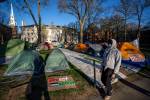Civilian Conservation Corps helped shape recreation in Spring Mountains
No sleuthing equipment is necessary to see the fingerprints of the Civilian Conservation Corps on Mount Charleston .
Many of the amenities, trails and campgrounds residents enjoy today were built by the public work relief program that dispatched thousands of men ages 18-25 to reshape and develop rural lands during the unemployment sinkhole of the Great Depression .
The face of Humboldt-Toiyabe National Forest in the Spring Mountains National Recreation Area was changed forever by new flood control, reforestation and road, trail and recreation areas constructed by "the C s, " said U.S. Forest Service district archaeologist Kelly Turner .
About 4,000 men in 40 camps around Nevada were housed, fed and employed from 1933- 42 through the CCC and the Works Progress Administration .
But the Mount Charleston CCC missed a meeting with the man who wrote its checks, Turner said.
In 1935, Franklin D. Roosevelt was in Nevada for the dedication of Hoover Dam. He received word that crews employed by his New Deal brainchild were hard at work on nearby Mount Charleston, she said.
He tacked on to his agenda a spontaneous visit, and the trip was a surprise twofold.
It was the one year the CCC camp was closed.
The corps' government partner, the Works Progress Administration, was busy with construction of Harris Springs Road , a would-be access route from Lee and Kyle canyons to Pahrump , according to "The Civilian Conservation Corps in Nevada: From Boys to Men" by Renee Corona Kolvet and Victoria Ford .
"Roosevelt's surprise visit scared the crap out of the foreman," Turner said. "He asked them what they were doing, and through complete mental blank, (the foreman) said, 'I don't know.' "
Roosevelt answered, "If you don't know where it's going, then why are we doing it?" and shut down operations, Turner said.
The Works Progress Administration snafu and the CCC absentee moment were but blips in the overall progress landscape.
The CCC would work in the Moapa Valley during the winter and go into Mount Charleston during the summer, according to "Water: A History of Las Vegas " by Florence Lee Jones and John F. Cahlan .
Mount Charleston was a fledgling area recently minted with national recognition. Advocates reclaimed the area after it was nearly ravaged by logging and hungry for renewal.
"Back in the 1930 s (when I was a baby), there were no water wells, no paved roads, no permanent homes in this area," Dick Taylor wrote in his booklet "An Alpine Village in a Pine Tree Forest."
The late historian noted that the CCC camp , Camp Charleston Mountain , was at the current site of the Spring Mountains Visitor Center . It was also an R&R camp for the military during World War II.
Farther down state Route 157 , the CCC improved and extended the road connecting Kyle and Lee canyons, Turner said.
The crews cleared about 50,000 acres of trees ravaged by the pine beetle and made areas for a tobogan run and ski jump during winters. Trails for Mummy Springs , the north and south loops of Cathedral Rock , Robber's Roost and more were paved by the CCC, Turner said.
A water system serving campgrounds still utilized today was also made by CCC manpower.
"It probably would have taken a lot longer for the campgrounds and what not we have to be built without the CCC," Turner said. "The forest might not look that different; it just would have meant through the '40s, '50s and '60s, the recreation opportunities would have been less."
The CCC and the Works Progress Administration disbanded as World War II began .
The U.S. Forest Service is currently updating several campgrounds and recreation areas used by millions of people each year.
For more information, visit gomtcharleston.com.
Contact Centennial and North Las Vegas View reporter Maggie Lillis at mlillis@viewnews.com or 477-3839.




























